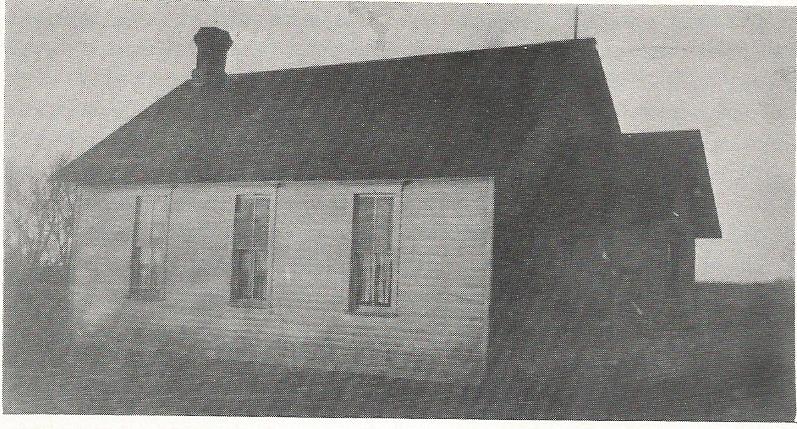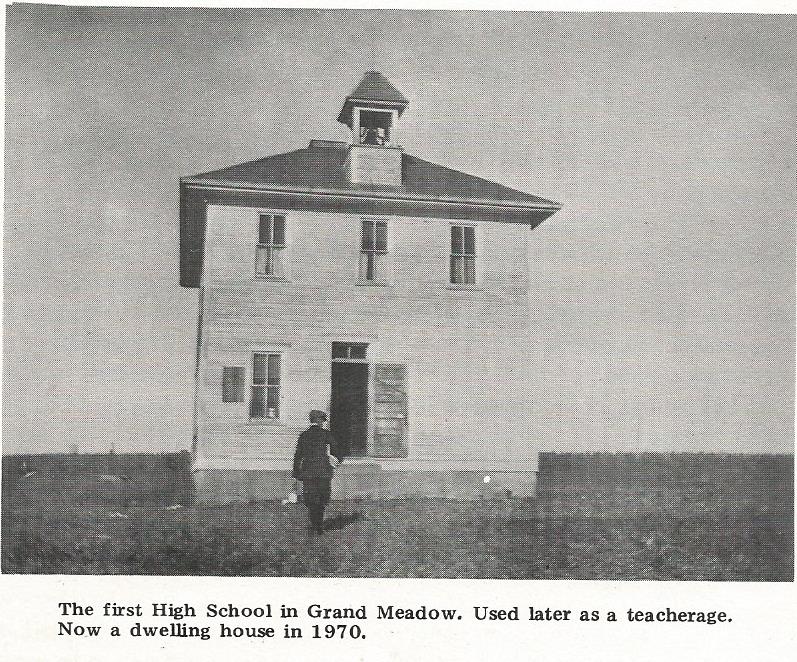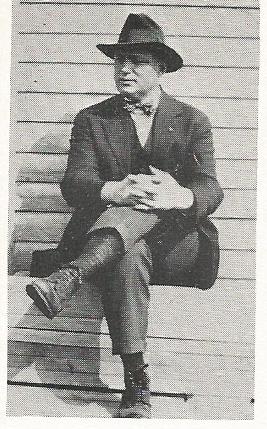Grand Meadow Township School Houses
#
1 Traver in Section 1
# 2 Henderson in Section 4
# 3 Ewoldt in Section 8
# 4 Prunty in Section 20
# 5 Center in Section 21
# 6 Drefke in Section 23
# 7 Gere in Section 26
# 8 Reeds in Section 28
|

|
|
Early History of Grand Meadowby Ella Heaton Irwin - written in 1970
On
January 19, 1877, Cherokee County was subdivided. Grand Meadow
was described as Twp. 90, range 42. In 1868 Frank Kimberly
located on Sections 19 and 20. (In 1970, 19 was the home of Larry
Klingensmith) It is thought school and worship convened in the Kimberly
home. Other names mentioned as earliest settlers were a Mr. Nash
and a Mr. Baldwin. In 1881 they moved from the community. March
6, 1879, the township of Grand Meadow was organized and named.
Early settlers who signed the petition were: G. Otto
Pixler, Henry Luge, T. J White, August W. Nafe, John H. Baker, J. W.
Lease, G. A. Bushman, Jerome Card, Aaron Card, Isaac A Harvey, R. D.
Harvey, F. C. Noe and James Parkinson. Very
early a desire for a place to worship and to educate the children
became a reality. In 1881 the United Brethren from Kingsley
organized and built a church, "Evening Star", located on Sec 17 (Iver
Johnson farm). A few years later this church was moved across the road
from G. M cemetery on Harrison land. In early 1900's, it was struck by
lightning and was burned and was not rebuilt. Other early
churches were "Morning Star" (Evangelical), "Trinity" (Evangelical),
"Providence" (Methodist" and "United Brethren", now merged and called
"United Methodist."In
1877, Lone Star School was located one mile north of Meadow Star
Church. Today's older citizens have no recollection of such a
school.In
1881 two one-room schools were built. One at Grand Meadow
Township center (Dist 5) and the other two miles south of Center, known
as the John Crom School, later as the the Fuller School or Dist. No. 8.
Logs were floated down Little Sioux River from Cherokee to Washta to
build these two schools.
My mother, Mrs. Lewis (Estelle) Heaton,
taught the first school at Center in 1882 and 1883. She rode
horseback, side-saddle, from the Heaton home - one half mile south of
Fielding. During the week she stayed at the Dalzel home - a
quarter of a mile east of the school. Mrs. Dalzel was fearful to have
her walk alone. "She might be attacked by bands of hungry wolves."
It
is interesting and perhaps a precedent that her three daughters, Maude
Barkley Keck, Ella Irwin, and Lula Heaton, down through the years,
taught schools in Grand Meadow, as did her daughters-in-law Susie
O'Donnell and Florence Rockwell. Her youngest son, Floyd,
attended the first high school for two years before entering the
service. He later married Susie O'Donnell. Her son Lewis
married Florence Rockwell.
Also of interest, in 1946 Mrs.
Heaton's son-in-law, James W. Irwin (Jim) and grandson, James L.
Irwin, remodeled the same school building into a dwelling for Supt.
Ball and family. This now occupied by a teacher.
Grand
Meadow's Consolidated's first well was dug with spades by James W.
Irwin and her son, Lewis Heaton, Jr. (Jim had the longest tenure as bus
driver, after consolidation). Also he was township clerk for over 35
years and I was registrar of births and deaths during these years.
My father, Lewis Heaton, Uncle Ed Heaton (who lived on the Wm.
Downey farm) and Jim Haggin (who lived just north of the cemetery)
plotted and placed marking stones on each cemetery lot. They also
planted the evergreens which border the cemetery. (I think George
Harrison Sr. assisted with the planting of evergreens).
Later
seven more district schools were built so that every two miles there
was a school. Elsewhere as near as possible, a list is compiled
of the teachers who have taught in Grand Meadow schools.
1907 Township Maps
(Click images to enlarge)

Grand Meadow No. 3 One Room School House
(Click image to enlarge)
|

The first High School in Grand Meadow.
Used later as a teacherage. Now a dwelling house in 1978
|
|
For
some years people of Grand Meadow with County Superintendents interest
entertained the idea that their children were entitled to advantages of
an education superior to what they had had.
March 11, 1911, at
a regular peoples meeting a motion was carried that the directors of
the nine districts provide for a special election to vote on bonding
the township to the extent of $4,000 to build and equip a two story
school house erected on Center school ground - a high school
upstairs and a grade down.
Sept 5, 1911, a special election
favored the plan. Dec 22, 1911, the Grand Meadow Board adopted
resolutions for such. Jan 29, 1912, the two story building was
completed. The former one-room schoolhouse was moved across the
road on Cooper land for board meetings and a voting precinct.
After voting was done in the consolidated school, it was a
dwelling for several different families. Later it was again moved
onto school ground and remodeled for the superintendents home.
The
new building cost $3,266. There was a good barn on the ground costing
$250. The school was equipped with a good set of Manual Training tools
and benches, a library, a piano, free text books and gas lights.
Jan 29, 1912, school was opened for four and a half months with
C.A. Grubb as superintendent. Three boys, Will Hodge, Forrest
Hiller, Alvin Crom and three girls, Erma Hiller, Ila Kitson, and Ellen
Law were enrolled. Freshman course of study was Algebra, General
History, Rhetoric and English. In 1915 the three girls were
graduated. Later the three girls taught in grade schools in Grand
Meadow.
Quote by Erma Hiller McQueen: "We the Class of 1915,
mention a few comparisons of the present beautiful school building -
its modern showers, rest rooms, lunch room, gymnasium and stage and
teachers' homes, to our first High School. Our teachers roomed
with nearby neighbors. Instead of buses or cars we drove the
horse and buggy on all kinds of roads not graveled."
Before
consolidation, the township was set up in nine districts, two miles
apart each way. Each was a one-room schoolhouse. The teacher
usually boarded in the director's home and was his or her own janitor
and fired up an old heating stove which made it too hot close by and
freezing farther away. The pupils took turns walking to the
nearest far house and carried water to keep the water cooler filled.
The directors of these nine schools at the time of consolidation
were: No. 1, Henry Schleef; No. 2, D. J. Miller; No. 3, H. C. Smith;
No. 4, D. M. Harvey; No., 5, H. U. Klingensmith; No. 6, S. G. Dawson;
No. 7, Edd Fellom; No. 8, A. C. Powell; No. 9, C. P. Nafe.Consolidation
Time
marched on, and the population of Grand Meadow increased. Rumblings of
school consolidation were heard throughout the land. The parents
of the community realized this was an opportunity to better the
educational facilities of their area, and in 1919 voted to consolidate.
Bonds were let for $100,000.
George Williams of Washta
contracted to dig the basement and work started. Several local people,
including Ray Marsh, Howard Flisher, George Jenkins, Willie Dawson and
Delbert McQueen, worked with horses and scrapers. The building
progressed until the funds were exhausted and work stopped until
more funds could be voted.
The cornerstone was laid in 1920, the
contents of which seem to be unknown. The directors at that time
were H. U. Klingensmith, Albert Keck, Willis Carver, Leroy Pease,
T. J. Leesley, F. D. Harvey and A. H. Nafe. The building was not
entirely completed in time to start the 1920-1921 school year, so it
opened officially in the fall of 1921. The first faculty consisted of
D. F. Funkhauser, superintendent, Goldie Jackson, Lucille Shalla,
Florence Rockwell (high school teachers), Georgia Clark (seventh and
eighth), Alta Baker (fifth and sixth), June Mason (third and fourth),
and Lula Heaton (first and second). William Herrold was caretaker, and
his wife boarded the teachers.

Superintenden. Funkhauser
|
|
The earth removed from the
basement was used to level off the grounds and the old center high
school building was moved to the south to be used as a teacher's
residence. At one time it accommodated eight teachers and the
custodian and his wife. It now boasts one kitchenette apartment
upstairs.
The era of all single teachers passed and more
housing was needed. The original one-room center school had been moved
across the road and used as a town hall. Now it was moved back to
the five acre grounds and remodeled for the superintendents house.
Later another small building belonging to Roy Kintigh was moved to the
grounds and made into an apartment for a married couple (later torn
down) and a new home was also erected. The barn that originally housed
the buses had disappeared with the years, so the complex now consists
of the schoolhouse, teacherage, two homes, a temporary trailer home, a
manual training and a music building (quonset huts). The playground is
spacious and a lunchroom and kitchen have been incorporated into the
building.
In 1949 a kindergarten course was added to the
curriculum. In 1959, after much argument, culminating in some
farms being withdrawn from the district, reorganization with Marcus
took place. Starting in August 1962, all Grand Meadow High
students and all seventh and eighth grad pupils ceased attending the
local school. Since then, in order to eliminate extra teachers
and to keep the per-pupil cost down, some transfers have been made. One
year the entire sixth grade was bussed to Marcus as the class was too
small to warrant a special teacher. Other years, in order to
equalize classes, some Marcus pupils have attended Grand Meadow, on a
voluntary basis. At present the total enrollment is 158.
Since
reorganization, our part of the district has been represented on the
Board by Kenneth Irwin (six years), and at present by Marlin Hodge, who
has served three years.Dedication
On November 29, 1921, starting at 2 p.m., the Grand Meadow School was officially dedicated.
P. T. A. Organized
Shortly
after the new school opened, the patrons and faculty organized a
parent-teacher association, adopting by-laws and a constitution.
The following officers were elected: Lula Heaton, president; Alta
Baker, vice-president; and Mrs. O. K. Barkley, secretary and treasurer.
During the years, the meetings helped to promote community
solidarity. Lunch was served after the meetings, giving parents
an opportunity to become better acquainted with the teachers.
Volley ball was a favorite after-meeting pastime.
Interesting and informative programs have continued through the
years.
Alumni
The
first alumni association consisted of graduates of the Center High
School. They and their husbands or wives call themselves "The
Grand Meadow Group and the surviving members still meet annually.
The present alumni association was formed in the late twenties,
and was more or less active for several years. In 1934, in order to
revitalize it, a banquet was held in the school auditorium, which was
attractively decorated. The meal was served by the ladies of the
United Brethren and Morning Star churches.. President Glen
Klingensmith presided as toastmaster. The program included a
vocal solo by Mildred Little, a piano solo by Fern Baker, a male
quartet (Fuller, Elser, Woods, McQueen), a skit by Earl Fuller and
Lester Baker and a vocal solo by Marie Woods. Officers elected
for the year 1934-1935 were : Opal McQueen, president; Ruby Walker,
vice-president; and Esto Carver, secretary and treasurer. Records
have been lost, so their later activities are merely a matter of
memory. The present officers are: Mildren Naim, president; Wesley
Hirschman, vice-president; and Dorothy Bryant, secretary and treasurer.Source: Grand
Meadow Golden Jubilee compiled by the Grand Meadow Alumni for the
fifitieth anniversary of the Consolidated School. Dated July 7, 1970.
1907 Township Maps
(Click images to enlarge)

Grand Meadow Twp. School House Map
|

County Township Map
|
|
Map credit: Former Cherokee County Historical Society
|
|